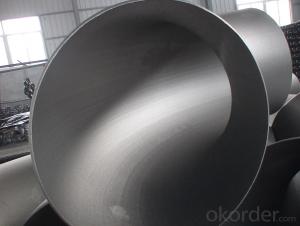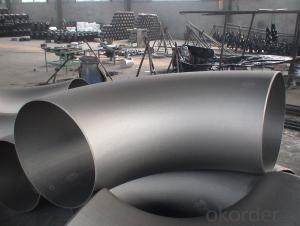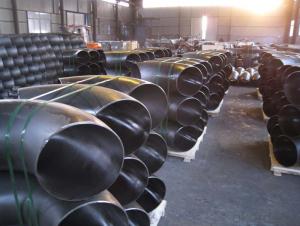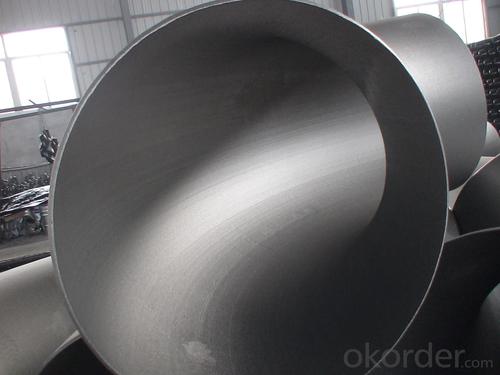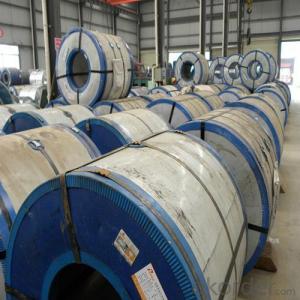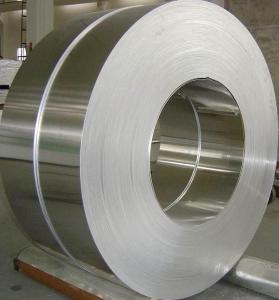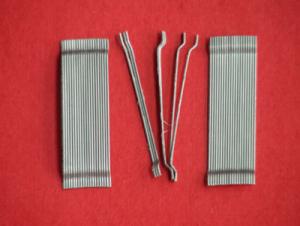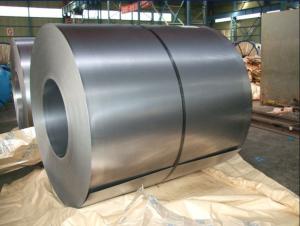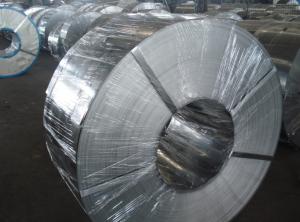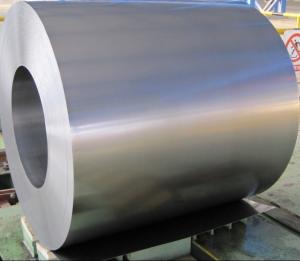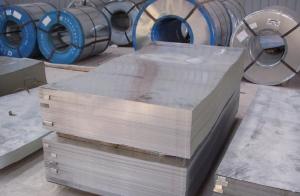Carbon steel pipe fittingsBEND 1/2'' SCH40
- Loading Port:
- China Main Port
- Payment Terms:
- TT OR LC
- Min Order Qty:
- -
- Supply Capability:
- -
OKorder Service Pledge
OKorder Financial Service
You Might Also Like
Pipe fitting is the occupation of installing or repairing piping or tubing systems that convey liquid, gas, and occasionally solid materials. This work involves selecting and preparing pipe or tubing, joining it together by various means, and the location and repair of leaks.
Pipe fitting work is done in many different settings: HVAC, manufacturing, hydraulics, refineries, nuclear-poweredSupercarriers and Fast Attack Submarinescomputer chip fab plants, power plant construction and other steam systems. Pipe fitters (sometimes called simply "fitters") are represented in the USA and Canada by the United Association of Journeymen and Apprentices of the Plumbing and Pipe Fitting Industry of the United States and Canada.
Fitters work with a variety of pipe and tubing materials including several types of steel, copper, iron, aluminium, and plastic. Pipe fitting is not plumbing; the two are related but separate trades. Pipe fitters who specialize in fire prevention are called Sprinklerfitters, another related, but separate trade.
Materials, techniques, and usages vary from country to country as different nations have different standards to install pipe.
Elbow are an English alternative rock band consisting of Guy Garvey (vocals, guitar), Richard Jupp (drums, percussion), Craig Potter (keyboards, piano), Mark Potter (guitar, backing vocals), and Pete Turner (bass guitar, backing vocals). They have played together since 1990, adopting the Elbow band name in 1997, and have released six studio albums: Asleep in the Back (2001), Cast of Thousands (2003), Leaders of the Free World (2005), The Seldom Seen Kid (2008), Build a Rocket Boys! (2011), and The Take Off and Landing of Everything (2014). All of their studio albums, as well as B-sides compilation Dead in the Boot (2012), have placed in the top 15 of the British album chart and seven of their singles have placed in the top 40 of the British singles chart.
In 2008 Elbow won the Mercury Music Prize for their album The Seldom Seen Kid, and in 2009 they won the Brit Award for Best British Group In 2012 they released "First Steps", the BBC theme for the 2012 London Olympics
Specifications
Standard: ASTM A234 WPB, JIS, DIN, EN, GOST
Use for Oil, Gas, Subwatering act.
45/90/180 degree, LR/SR Elbow
ASTM A234 WPB ELBOW :
| ||||||||
| we are manufacturer for carbon steel pipe and fittings,like 45deg,90deg,180deg,L/R OR S/R,bend , | ||||||||
| equal or reducing tee, CON reducer, ECC reducer, pipe cap,flange. | ||||||||
| CON AND ECC REDUCER: CARBON STEEL,STAINLESS,STELL,ALLOY STEEL | ||||||||
| NOMINAL DIAMETER | BIG OD1 | SMALL OD2 | HEIGHT(MM) | |||||
| MM | SERIES A | SERIES B | SERIES A | SERIES B | 51-711 | |||
| 25*15--1500*1400 | 33.7-1524 | 32-1520 | 21.3-1420 | 18-1420 | ||||
| MATERIAL: A234WPB,A283,A105,A53,A106,API5L | ||||||||
| STANDARD: ASTM/ANSI,DIN,ISO,GB,JIS,BS ,GOST | ||||||||
| OTHERS: | ||||||||
| 1. Special design available according to requirement | ||||||||
| 2. All the production process are made under the ISO 9001:2000 strictly. | ||||||||
- Q: How is steel used in the production of tools and hardware?
- Steel is commonly used in the production of tools and hardware due to its high strength and durability. It is used to make various components such as blades, wrenches, hammers, and screws, providing them with the necessary toughness to withstand heavy usage and resist wear and tear. Steel's versatility allows it to be shaped into different forms, enabling the creation of tools with precise dimensions and intricate designs. Additionally, steel can be hardened and tempered to enhance its performance, making it an ideal material for manufacturing reliable and long-lasting tools and hardware.
- Q: What are the different types of surface finishes for steel products?
- There are several types of surface finishes for steel products, including mill finish, brushed finish, mirror finish, galvanized finish, and powder-coated finish.
- Q: What is the role of steel in the energy sector?
- Steel plays a crucial role in the energy sector as it is used in the construction of various infrastructure and equipment necessary for energy generation, transmission, and storage. From power plants, wind turbines, and solar panels to pipelines, storage tanks, and transmission towers, steel provides strength, durability, and reliability to support the efficient and safe production, distribution, and utilization of different forms of energy.
- Q: How are steel wires used in various industries?
- Steel wires are widely used in various industries for their strength and durability. They play a crucial role in sectors such as construction, transportation, manufacturing, and agriculture. In construction, steel wires are used for reinforcing concrete structures, providing added strength and stability. In transportation, they are utilized in the production of automobile parts, aircraft cables, and railway tracks. Steel wires are also essential in manufacturing industries for making springs, cables, and wire mesh. Additionally, they find application in agriculture for fencing, vineyard support, and securing livestock. Overall, steel wires are versatile and indispensable components across a range of industries.
- Q: How is steel used in the manufacturing of consumer goods?
- Steel is used in the manufacturing of consumer goods in various ways, such as in the production of appliances, automobiles, furniture, and packaging materials. It is valued for its strength, durability, and versatility, allowing manufacturers to create sturdy and long-lasting products. Whether it's the frame of a car, the casing of a refrigerator, or the structure of a piece of furniture, steel plays a crucial role in ensuring the quality and reliability of consumer goods.
- Q: What are the advantages of using steel products over other materials?
- There are several advantages of using steel products over other materials. Firstly, steel is known for its exceptional strength and durability, making it highly resistant to wear, tear, and extreme weather conditions. Secondly, steel products have a longer lifespan compared to other materials, reducing the need for frequent replacements. Additionally, steel is a versatile material that can be easily molded and shaped to meet specific design requirements. Moreover, steel is recyclable, making it an environmentally friendly choice. Lastly, steel offers excellent fire resistance, making it a safer option in various applications.
- Q: What are the different types of steel pipes and their applications?
- There are several types of steel pipes, including seamless, welded, galvanized, and stainless steel pipes. Seamless pipes are manufactured without any welding or joints, making them suitable for high-pressure applications, such as oil and gas pipelines. Welded pipes are made by rolling steel plates or sheets into cylindrical shapes and then welding the edges together. They are commonly used in construction, infrastructure projects, and plumbing systems. Galvanized pipes are steel pipes coated with a layer of zinc, which provides protection against corrosion. They are commonly used in water supply systems, outdoor structures, and agricultural applications. Stainless steel pipes are highly resistant to corrosion and have excellent strength and durability. They find applications in industries such as chemical, pharmaceutical, and food processing, as well as in plumbing and architectural projects. Overall, the choice of steel pipe depends on factors such as the intended application, pressure requirements, corrosion resistance, and budget.
- Q: What are the different grades of tool steel and their applications?
- Tool steels are classified into different grades based on their chemical composition and properties. Some common grades include: 1. W-group tool steel: This grade includes water-hardening tool steels such as W1, W2, and W3. They are used for applications like punches, chisels, and woodworking tools. 2. O-group tool steel: Oil-hardening tool steels like O1, O2, and O6 belong to this grade. They offer high hardness, toughness, and wear resistance, making them suitable for cutting tools, punches, and dies. 3. A-group tool steel: Air-hardening tool steels like A2, A3, and A4 are part of this grade. They possess excellent toughness and wear resistance, making them ideal for forming tools, punches, and dies. 4. D-group tool steel: This grade includes high-carbon, high-chromium tool steels like D2, D3, and D6. They offer exceptional wear resistance and are commonly used for cutting tools, dies, and punches. 5. S-group tool steel: Shock-resisting tool steels like S1, S2, and S5 belong to this grade. They possess high impact resistance and are used in applications that involve heavy hammering or shock loads, such as hammers, chisels, and shear blades. 6. H-group tool steel: Hot-work tool steels like H11, H13, and H21 are part of this grade. They retain their hardness and strength at high temperatures, making them suitable for applications such as die casting, forging, and extrusion dies. Each grade of tool steel has specific properties that make it suitable for different applications, allowing for the selection of the most appropriate grade based on the desired performance requirements.
- Q: How is steel used in the construction of hospitals and healthcare facilities?
- Steel is an essential material in the construction of hospitals and healthcare facilities due to its strength, durability, and versatility. It is commonly used for structural purposes, such as beams, columns, and frames, providing a solid and sturdy framework for the buildings. Steel is also used in the construction of walls, roofs, and floors, ensuring stability and safety. Additionally, steel is often used for medical equipment and fixtures, as it can be easily shaped and fabricated to meet specific requirements. Overall, steel plays a crucial role in ensuring the structural integrity and functionality of healthcare facilities.
- Q: How are steel tubes used in the fabrication of bicycle frames?
- Steel tubes are commonly used in the fabrication of bicycle frames as they provide strength, durability, and flexibility. These tubes are cut, shaped, and welded together to form the main structure of the frame, ensuring stability and support for the rider. Additionally, steel tubes allow for customization in terms of design and geometry, enabling manufacturers to create frames that cater to different riding styles and preferences.
Send your message to us
Carbon steel pipe fittingsBEND 1/2'' SCH40
- Loading Port:
- China Main Port
- Payment Terms:
- TT OR LC
- Min Order Qty:
- -
- Supply Capability:
- -
OKorder Service Pledge
OKorder Financial Service
Similar products
Hot products
Hot Searches
Related keywords
